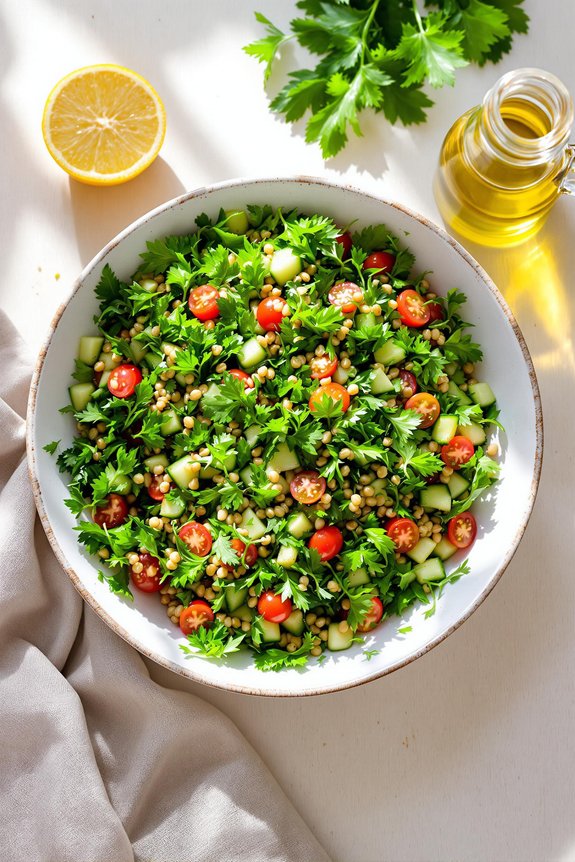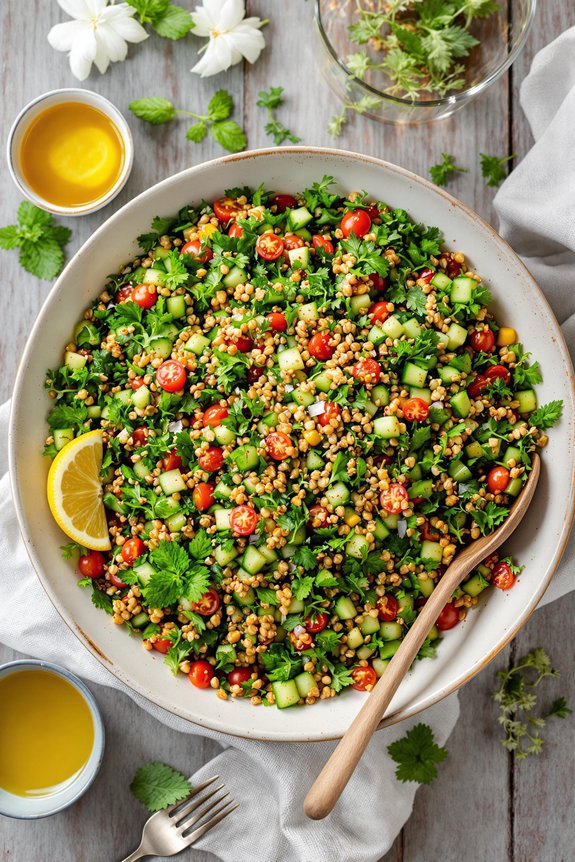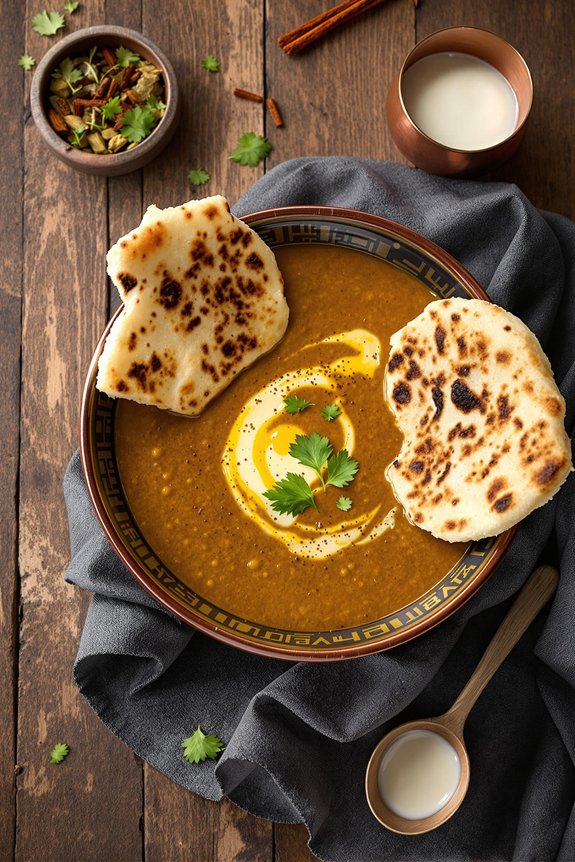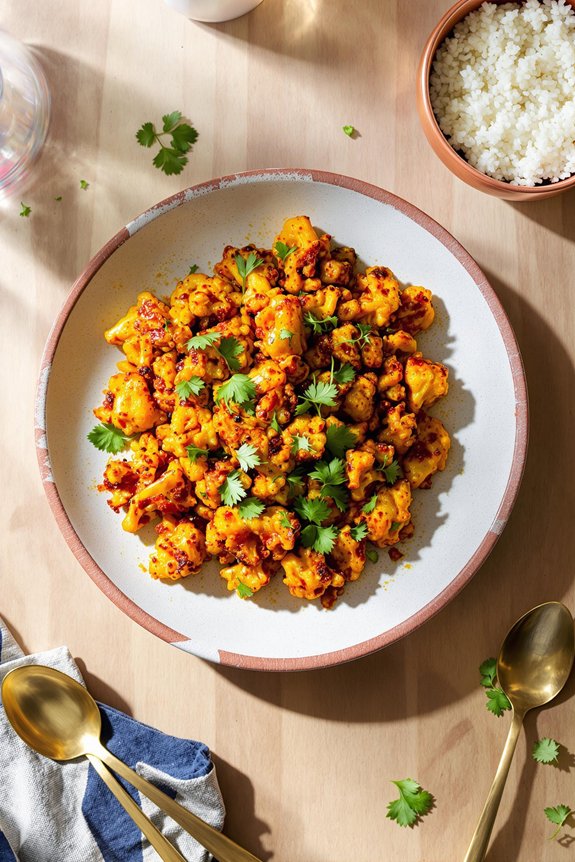Why You’ll Love this No-Fuss Lebanese Tabbouleh
While many traditional recipes call for laborious chopping and precise measurements, this no-fuss Lebanese tabbouleh delivers authentic flavor without the hassle. I’m all about simplicity in the kitchen, and this recipe truly delivers.
You’ll appreciate how the bulgur wheat soaks while you prep other ingredients, creating a wonderful time-saving overlap. The fresh herbs bring brightness without requiring professional knife skills, and the lemon-olive oil combination creates that signature tangy dressing we all crave.
Perfect for busy weeknights or impressing weekend guests. Isn’t it wonderful when something this delicious takes so little effort?
What Ingredients are in No-Fuss Lebanese Tabbouleh?
The beauty of this Lebanese tabbouleh lies in its simple, fresh ingredients that come together to create something truly special.
Traditional tabbouleh relies heavily on parsley as the star, with the grain playing a supporting role, but what makes this recipe so approachable is how it balances those elements perfectly. Each component brings its own texture and flavor to create that authentic Mediterranean taste we crave.
- 110g bulgur wheat (or 100g couscous as an alternative)
- 600ml water for soaking
- 1/2 cucumber, diced
- 2 medium tomatoes, deseeded and diced
- Juice of 1 lemon
- 1/4 cup fresh parsley, chopped
- 1/4 cup fresh mint, chopped
- 1 tablespoon olive oil
When shopping for these ingredients, quality really matters. I recommend finding the freshest herbs possible—they’re what gives tabbouleh its distinctive aroma and bright flavor.
And while extra virgin olive oil isn’t explicitly specified, using a good quality one makes a noticeable difference in the final taste.
Can’t find bulgur? The couscous substitution works remarkably well for those nights when you’re working with what’s already in your pantry.
Either way, this ingredient list proves that sometimes, the simplest combinations create the most memorable dishes.
How to Make this No-Fuss Lebanese Tabbouleh

Making this Lebanese tabbouleh couldn’t be simpler—just a few steps stand between you and this invigorating Mediterranean classic. Start by soaking 110g of bulgur wheat (or 100g of couscous if that’s what you have) in 600ml of water for about 30 minutes. This softening process is essential, as it transforms the grain without requiring any actual cooking.
After the soaking time is up, drain thoroughly and—this is important—squeeze out any excess water. Nobody wants soggy tabbouleh, right? The grain should be tender but still have a slight chew to it.
Next, toss in your 2 medium deseeded and diced tomatoes along with the 1/2 cucumber that you’ve diced into small, bite-sized pieces. Let this mixture stand for another 30 minutes, which allows the flavors to mingle and develop. This resting period might seem like an unnecessary step when you’re hungry, but trust me, it makes all the difference in the final flavor.
During this time, the juices from the vegetables will slightly permeate the grain, creating that cohesive tabbouleh texture we all love.
For the finishing touch, drizzle in 1 tablespoon of olive oil and the juice of 1 lemon, then fold in 1/4 cup each of freshly chopped parsley and mint. For an authentic luxury touch, consider adding a few threads of Spanish saffron to elevate the dish with its distinctive flavor and aroma. The herbs bring everything to life with their brightness and aroma.
Give everything a good toss to make sure the dressing coats each grain and vegetable piece evenly. And just like that, your no-fuss tabbouleh is ready to serve!
It works beautifully as a side dish, but honestly, I often enjoy a big bowl of it as a light meal on hot summer days. The flavors actually continue to develop if you refrigerate it, making it a perfect make-ahead option for busy weeknights or gatherings.
No-Fuss Lebanese Tabbouleh Substitutions and Variations
Several clever substitutions can transform this classic Lebanese tabbouleh to suit your pantry and preferences.
Can’t find bulgur? Couscous works beautifully as noted in the recipe, but quinoa offers a protein-packed, gluten-free alternative.
For a colorful twist, try adding pomegranate seeds, diced bell peppers, or even chickpeas for extra protein.
Not a mint fan? Double up on the parsley instead.
The dressing can be customized too—a touch of garlic, a sprinkle of sumac, or a dash of cumin brings new dimensions.
And if you’re feeling rebellious, crumbled feta makes a decidedly non-traditional but delicious addition.
What to Serve with No-Fuss Lebanese Tabbouleh
While tabbouleh shines as a standalone dish, pairing it with complementary foods elevates your entire meal experience.
I love serving mine alongside grilled proteins like chicken skewers, lamb kebabs, or even a simple piece of salmon. The brightness of the herbs cuts through rich meats perfectly.
For a vegetarian spread, try it with warm pita bread, creamy hummus, and tangy labneh.
Falafel makes another dreamy companion, creating that authentic Middle Eastern platter vibe.
Need a quick lunch? Tabbouleh works beautifully stuffed into halved bell peppers or wrapped in lettuce leaves for a light, invigorating meal.
Final Thoughts
After enjoying this simple Lebanese tabbouleh for years, I’m convinced it’s one of those perfect dishes that proves good food doesn’t need to be complicated.
The bright flavors of fresh herbs, the satisfying texture of bulgur, and that citrusy punch—they all come together in a dish that’s both nourishing and delightful.
What makes this recipe special is its versatility. You can adjust the herb ratios, try couscous instead of bulgur if that’s what you have on hand, or even add a pinch of allspice for an unexpected twist.
Isn’t that the beauty of classic recipes? They leave room for your personal touch.




